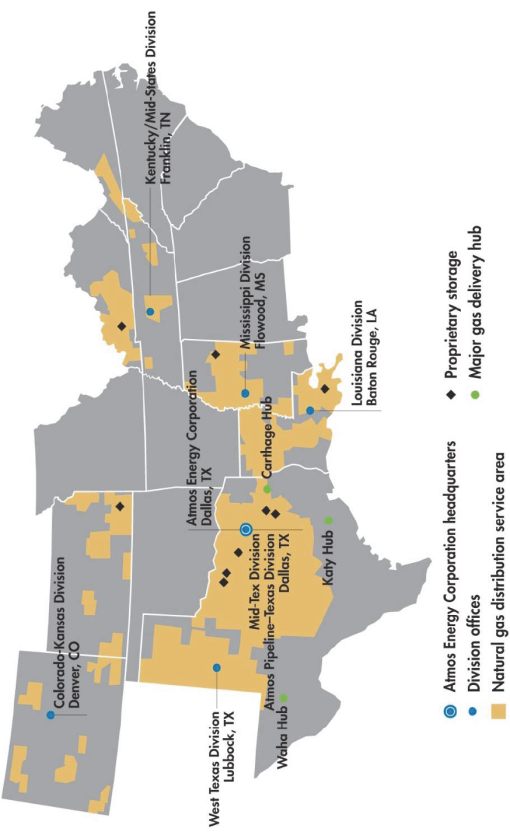Prospectus supplement
(To prospectus dated February 11, 2020)

Atmos Energy Corporation
Common stock
Having an Aggregate Offering Price of up to $1,000,000,000
This prospectus supplement and the accompanying base prospectus relate to the offer and sale from time to time of shares of common stock of Atmos Energy Corporation having an aggregate offering price of up to $1,000,000,000 through one or more of the sales agents named in this prospectus supplement (the “sales agents”). These sales will be made over a period of time and from time to time in transactions at then-current prices, pursuant to an equity distribution agreement between us and the sales agents. The equity distribution agreement provides that, in addition to the issuance and sale of common stock by us through the sales agents, we also may enter into forward sale agreements under separate master forward sale confirmations and related supplemental confirmations between us and each of Morgan Stanley & Co. LLC, BNP Paribas, Canadian Imperial Bank of Commerce, Credit Agricole Corporate and Investment Bank c/o Credit Agricole Securities (USA) Inc., as Agent, Goldman Sachs & Co. LLC, JPMorgan Chase Bank, National Association, Bank of America N.A., Mizuho Securities USA LLC, MUFG Securities EMEA plc, The Toronto-Dominion Bank and Wells Fargo Bank, National Association. We refer to these entities, when acting in such capacity, as forward purchasers. In connection with each forward sale agreement, the relevant forward purchaser will, at our request, borrow from third parties and, through the relevant sales agent, sell a number of shares of our common stock equal to the number of shares of our common stock that underlie the forward sale agreement to hedge the forward sale agreement. We refer to each of Morgan Stanley & Co. LLC, BofA Securities, Inc., BNP Paribas Securities Corp., CIBC World Markets Corp., Credit Agricole Securities (USA) Inc., Goldman Sachs & Co. LLC, J.P. Morgan Securities LLC, Mizuho Securities USA LLC, MUFG Securities Americas Inc., SunTrust Robinson Humphrey, Inc., TD Securities (USA) LLC and Wells Fargo Securities, LLC, when acting as the agent for a forward purchaser, as a forward seller. In no event will the aggregate number of shares of our common stock sold through the sales agents as our agents and by the forward sellers under the equity distribution agreement have an aggregate sales price in excess of $1,000,000,000.
We will not initially receive any proceeds from the sale of borrowed shares of our common stock by a forward seller. We expect to receive proceeds from the sale of shares of our common stock upon future physical settlement of the relevant forward sale agreement with the relevant forward purchaser on dates specified by us on or prior to the maturity date of the relevant forward sale agreement. If we elect to cash settle or net share settle a forward sale agreement, we may not (in the case of cash settlement) or will not (in the case of net share settlement) receive any proceeds, and we may owe cash (in the case of cash settlement) or shares of our common stock (in the case of net share settlement) to the relevant forward purchaser.
Sales of common stock under this prospectus supplement, if any, will be made by means of ordinary brokers’ transactions through the facilities of the New York Stock Exchange (the “NYSE”), at market prices, in block transactions or as otherwise agreed between us and the sales agents. The sales agents are not required to sell any specific dollar amount of shares of common stock but will use their commercially reasonable efforts, as our agents and subject to the terms of the equity distribution agreement, to sell the shares offered as instructed by us.
The compensation to the sales agents for sales of common stock will be a fixed commission rate of 1.00% of the gross sales price per share. See “Plan of Distribution (Conflicts of Interest)” beginning on pageS-16 for additional information regarding the compensation to be paid to the sales agents. In connection with each forward sale agreement, the relevant forward seller will receive, reflected in a reduced initial forward sale price payable by the relevant forward purchaser under its forward sale agreement, a commission of 1.00% of the volume weighted average of the sales prices of all borrowed shares of our common stock sold during the applicable period by it as a forward seller. The net proceeds from any sales under this prospectus supplement will be used as described under “Use of Proceeds.”
Our common stock is listed on the NYSE under the symbol “ATO.” The last reported sales price of our common stock on February 11, 2020 was $119.35.
Investing in our common stock involves risks. See “Risk Factors” beginning on pageS-3 of this prospectus supplement and page 3 of the accompanying prospectus.
Neither the Securities and Exchange Commission (the “SEC”) nor any state securities commission has approved or disapproved of these securities or passed upon the adequacy or accuracy of this prospectus supplement. Any representation to the contrary is a criminal offense.
| | | | | | |
| Morgan Stanley | | BofA Securities | | BNP PARIBAS | | CIBC Capital Markets |
| Credit Agricole CIB | | Goldman Sachs & Co. LLC | | J.P. Morgan | | Mizuho Securities |
| MUFG | | SunTrust Robinson Humphrey | | TD Securities | | Wells Fargo Securities |
The date of this prospectus supplement is February 12, 2020.


